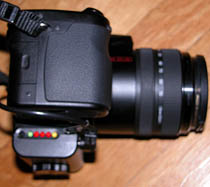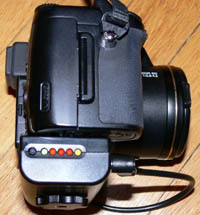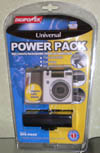Review: Digipower DPS-9000 power pack for digital cameras
Digipower’s DPS-9000 power pack is a universal battery that attaches to many (but not all) different digial cameras and camcorders. It attaches to the camera via a tripod mount. With the high cost of replacement OEM batteries, is this a viable alternative? We tested one for a couple of weeks to find out.
The DPS-9000 is a small device, about the size of a pack of cards, that includes a tripod screw to mount it to the bottom of your digital camera. You then connect a cable between the unit and your camera’s DC IN jack to power the device, usually for much longer than the built-in battery. A tripod mount is included at the bottom so you can still use a tripod.
Compatibility
 Upon opening the DPS-9000 box, I was surprised to find a large number of components:
Upon opening the DPS-9000 box, I was surprised to find a large number of components:
- DPS-9000 Lithium Ion Rechargeable Battery Pack
- Four different connector cables (see below)
- EC-575 Auto-Switching Power Supply
- Cigarette Lighter Adapter Charger
- EC-512 Charging Interface Adapter
This unit supports most 7.2V digital cameras and camcorders, using different cables for different cameras:
- DP-4U: Canon, Casio, HP, Minolta, Toshiba
- DP-1U: Agfa, Epson, Kodak, Nikon, Olympus, Vivitar
- DP-5: Fuji
- DP-1S: Sony
A detailed list of compatible models is included with the unit. While Panasonic isn’t listed, it works perfectly with my FZ-30 (using the DP-1U cable) and others have reported good results as well. The DP-5 cable includes a small box that converts the voltage to 5V, enabling its use on Fuji cameras and probably other devices.
Usability
It’s simple to screw the DPS-9000 onto a camera’s tripod mount, and the included cables are the right length to reach the power adapter without getting in the way. The DPS-9000 fits perfectly on my Panasonic FZ-30—in fact, it looks like it’s made for it, and adds a good counterweight to the heavy lens. (left image) On the smaller Nikon CP5700, the 9000 appears bulkier but still fits nicely. (right image)


To use the unit, you just attach the appropriate cable to the DC IN jack on the camera. For best results, remove the camera’s battery while using it.
A group of five LEDs and a button on the side of the unit allow you to quickly check the current power level and know when it’s time to charge.
To charge the DPS-9000, you connect it to the charger (a small box with attached cable) and connect either the AC power supply or the 12V car adapter to the charger. Charge time is about four hours, and an LED indicates when the charge is complete by changing from orange to green.
Battery Life
The DPS-9000 is a 7.2V lithium battery pack rated at 2000 mah (milliamp hours). By contrast, an average digital camera battery is 700 mah. In my tests with the Panasonic FZ-30, it easily lasts at least three times as long as the included 720 mah battery.
I have not yet run the DPS-9000 all the way down, but after taking 1000 pictures it still had about 1/3 of a charge remaining. When I’m using it, I abandon my usual battery-conserving practices—for example, I took a 1-hour hike and took 120 pictures, leaving the camera and LCD display on the entire time. The camera was always ready to take a shot, and after the hike the DPS-9000 still lit up all five LEDs on the charge meter.
Warnings
While this is a great addition to any digital camera, there are a few caveats:
- It’s a good idea to remove the standard battery while using the DPS-9000, since it will waste power trying to charge the battery instead of running the camera.
- On some cameras, the automatic power-off feature doesn’t work when the camera is plugged into the DPS-9000—since it attaches like an AC adapter—so be sure to turn it off when not in use.
- On smaller cameras, the DPS-9000 adds quite a bit of weight, and it dramatically changes the balance point on any camera, so be careful when sitting the camera on a table or tripod.
Conclusion
Battery life has been a constant issue in my experience with digital cameras. While the newer and larger cameras last a great deal longer, the battery still runs out before I run out of time or memory cards. With the DPS-9000, I have an effectively unlimited supply of power, and it’s great not to have to worry about batteries at all.
Since it costs about the same as a single OEM replacement battery for your camera, the DPS-9000 is an unbeatable value if you don’t mind a bit of added weight and bulk.

I have a DPS 9000 battery and I looking for a connecter cable for the power shot S5 Is…to fit this camera to the DSP 9000 battery… thank’s
Comment by jose — April 22, 2008 @ 6:55 am
I have a quick question as I can not find any data regarding it. Is this compatible with the Canon SXC10IS ?? much is appreciated.
If this by any chance is not compatible, please inform me what unit I can use for heavy picture taking , in several hours sporting events. thank you.
Robert.
Comment by Robert — November 22, 2008 @ 1:44 pm
Robert,
Here is the compatibility list from the manufacturer:
Check to see if your camera is on their list.
Best, Laura Moncur
Comment by Laura Moncur — November 22, 2008 @ 6:22 pm
Hi Laura: My BP-400 Lithium/Ion batteries for my Sigma SD-14 camera are about 16 months old, and they are simply not holding charges, nor charging up to full capacity any more; I always run new batteries through a couple of full discharge cycles to condition them at first, but I guess that over time batteries just wear out in their ability to fully charge.
I’m wondering if the DPS-9000 will have a longer “life”? Do you have any feedback on that? And, I assume I should treat the battery pack like any other, and give it a couple of full charge/discharge cycles to “condition” it at first?
Thank you.
Laurence
Comment by Laurence — March 22, 2009 @ 10:24 am